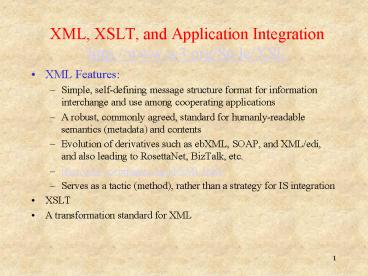XML, XSLT, and Application Integration http:www.w3.orgStyleXSL - PowerPoint PPT Presentation
1 / 13
Title:
XML, XSLT, and Application Integration http:www.w3.orgStyleXSL
Description:
A collection of domain-associated names used in an XML document. ... In schema conversion: Extracting data. Validating data. Persisting data ... – PowerPoint PPT presentation
Number of Views:81
Avg rating:3.0/5.0
Title: XML, XSLT, and Application Integration http:www.w3.orgStyleXSL
1
XML, XSLT, and Application Integrationhttp//www.
w3.org/Style/XSL
- XML Features
- Simple, self-defining message structure format
for information interchange and use among
cooperating applications - A robust, commonly agreed, standard for
humanly-readable semantics (metadata) and
contents - Evolution of derivatives such as ebXML, SOAP, and
XML/edi, and also leading to RosettaNet, BizTalk,
etc. - http//xml.coverpages.org/ebXML.html
- Serves as a tactic (method), rather than a
strategy for IS integration - XSLT
- A transformation standard for XML
2
A View of XML
3
Essence of IS Integration Value of XML
- IS integration
- Binding of applications and data stores for
aggregated (cooperative processing) - Constructs infrastructure that supports the flow
of information between trading partners, next EDI - XML provides a common data-exchange format for
data and metadata
4
XML Document Content Structure Specification
5
Parsing XML Documents
- XML parsers read XML documents and extract data
for access by other applications - XML parsers can be embedded in the middleware
- XML is being used common enterprise metadata
repository - Individual industries such as pharmaceuticals and
automotives can define their separate industry
specific product metadata and document structure
6
XML Namespaceshttp//bertram.bourdrez.org/lecture
15.pdf
- Namespace
- A collection of domain-associated names used in
an XML document. - Same name may be used for two different meanings
- A Uniform Resource Indicator (URI) makes each
namespace to be unique, e.g. - http//www.bank.com.account
- http//www.hotel.com.account
7
Some XML Limitations
- For integration, enterprise information has to be
externalized - Existing applications need to be modified for
producing and consuming XML, or leverage
XML-enabled middleware. - XML is text based, requiring more space than the
enterprise information normally existing in
binary format. - Middleware often moves XML information into
binary for format for exchange.
8
XML and Middleware
- XML needs middleware and middleware needs XML
- Middleware becomes the mover of information and
dealing with application interfaces - XML is playing a pervasive role in middleware.
Products can be easily XML enabled by simply
embedding a parser.
9
XML Enabled Standards
- Standards organizations are developing standards
for e-business that are being used increasingly
by vendors - Overabundance of standards organizations and
standards is problematic until a few widely
accepted standards are in use. - Examples
- RosettaNet consortium of vendors and users for
high tech industry - XEDI how to map EDI versus XML
- BizTalk Microsoft founded consortium to define
grammar for XML-based messaging and metadata - XFRML Advanced by American Institute of
Certified Public Accountants (AICPA) - XMLSchema W3C working group for improved
mechanisms for determining XML document structure - XML-Query - W3C for creating a common set of
operations and language to access persistent data - XSLT provides a standard for XML document
transformation using style sheets as the common
processing engine. Provides for alteration of
information in exchanges.
10
XSLT and B2B Application Integrationhttp//www-12
8.ibm.com/developerworks/xml/library/x-xslt
- B2B requires services such as routing, rules
processing, and transformation - XSLT provides a standard approach for rules and
transformation processing - Developed by W3C, it could become the preferred
standard - XSLT is simple and tightly integrated with XML
- XSLT allows for creation of transformation
services
11
XSLT and B2B (continued)
- XSLT can also be used to perform other types of
text processing and transformations for comma
delimited files such as PDF, Excel, etc. - XSLTs requires textual rather than binary
information. Building text processing into
existing binary messaging systems extra effort. - Biztalk manages information in XML and makes use
of XSLT - XSLT fits in the middleware
12
XSLT Processors
- XSLT requires a SAX or DOM compliant for
processing nodes of the XML document tree - XSLT processors are also enables to handle
multiple document inputs, multiple style sheet
inputs, and multiple document outputs
13
XSLT Applications
- In addition to application integration, XSLT has
other applications - In schema conversion
- Extracting data
- Validating data
- Persisting data
- Converting attributes to elements
- Converting elements to attributes
- Changing the metadata and content of an incoming
XML document to creating a new XML document - Converting to other forms
- EDI/XML
- XML/PDF etc.
- Publishing information in the text format
required by publishing systems































